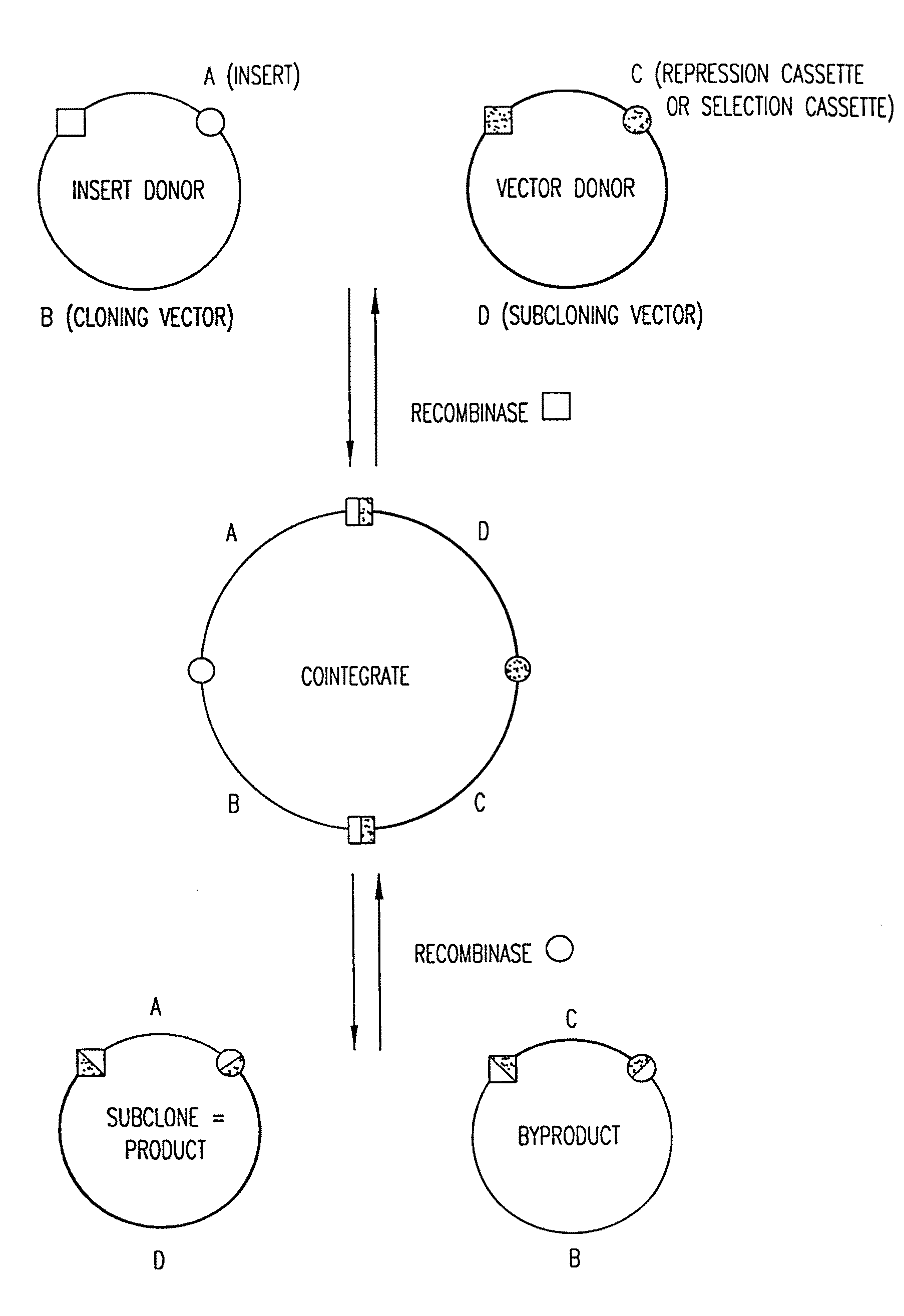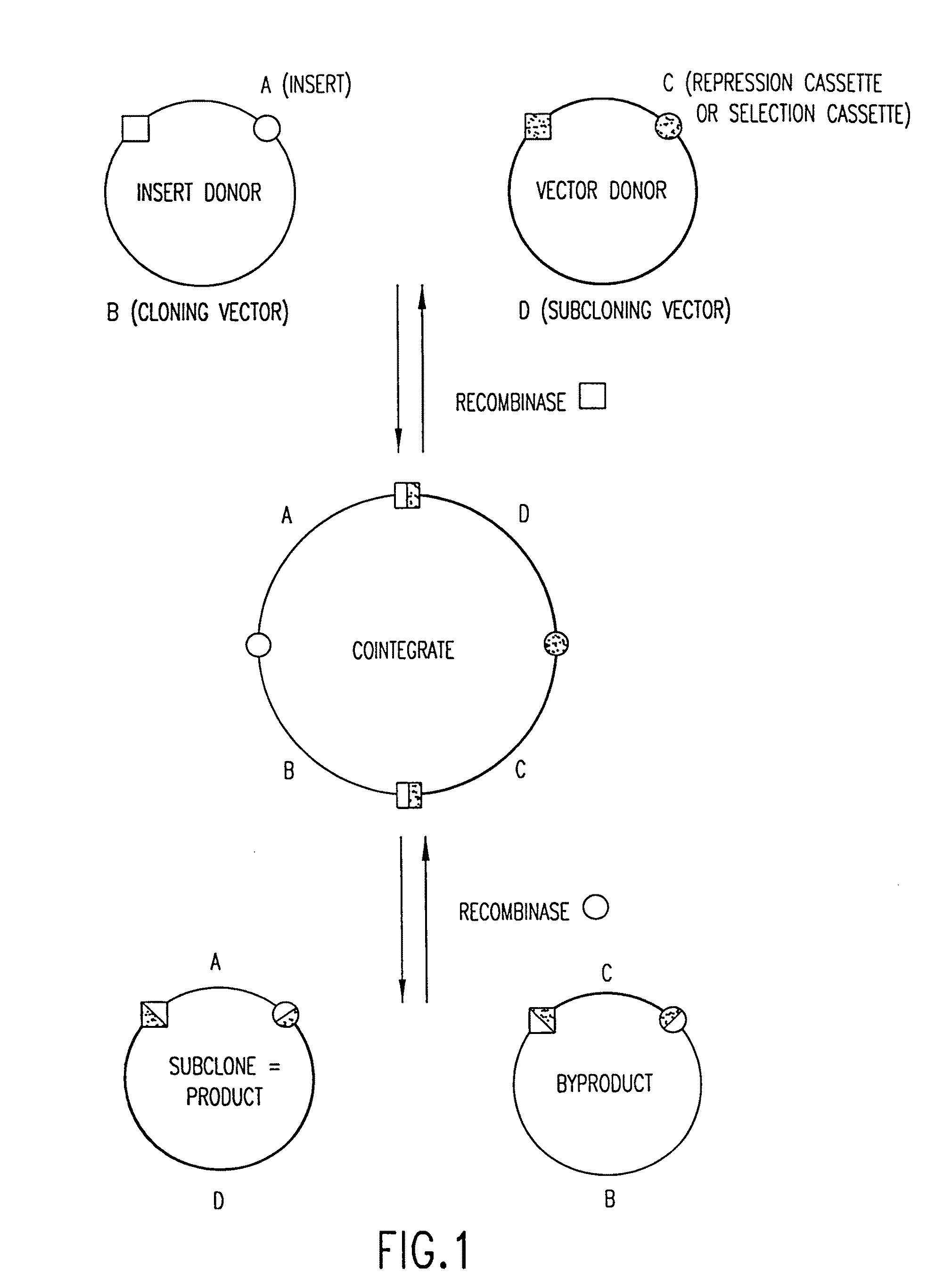Compositions for use in recombinational cloning of nucleic acids
a technology of nucleic acid and composition, applied in the field of recombinant dna technology, can solve the problems of toxic genes, many other subclonings can take several weeks, and many other subclonings involve unknown sequences, so as to reduce time and cost in preparation, the effect of being convenient to use and reducing the cos
- Summary
- Abstract
- Description
- Claims
- Application Information
AI Technical Summary
Benefits of technology
Problems solved by technology
Method used
Image
Examples
example 1
Recombination Reactions of Bacteriophage λ
[0343]The E. coli bacteriophage λ can grow as a lytic phage, in which case the host cell is lysed, with the release of progeny virus. Alternatively, lambda can integrate into the genome of its host by a process called lysogenization (see FIG. 60). In this lysogenic state, the phage genome can be transmitted to daughter cells for many generations, until conditions arise that trigger its excision from the genome. At this point, the virus enters the lytic part of its life cycle. The control of the switch between the lytic and lysogenic pathways is one of the best understood processes in molecular biology (M. Ptashne, A Genetic Switch, Cell Press, 1992).
[0344]The integrative and excisive recombination reactions of λ, performed in vitro, are the basis of Recombinational Cloning System of the present invention. They can be represented schematically as follows:
attB x attPattL x attR (where “x” signifies recombination)
[0345]The four att sites contai...
example 2
Recombination Reactions of the Recombinational Cloning System
[0346]The LR Reaction—the exchange of a DNA segment from an Entry Clone to a Destination Vector—is the in vitro version of the λ excision reaction:
attL x attRattB+attP.
[0347]There is a practical imperative for this configuration: after an LR Reaction in one configuration of the present method, an att site usually separates a functional motif (such as a promoter or a fusion tag) from a nucleic acid molecule of interest in an Expression Clone, and the 25 bp attB site is much smaller than the attP, attL, and attR sites.
[0348]Note that the recombination reaction is conservative, i.e., there is no net synthesis or loss of base pairs. The DNA segments that flank the recombination sites are merely switched. The wild type λ recombination sites are modified for purposes of the GATEWAY™ Cloning System, as follows:
[0349]To create certain preferred Destination Vectors, a part (43 bp) of attR was removed, to make the excisive reaction ...
example 3
Protein Expression in the Recombinational Cloning System
[0352]Proteins are expressed in vivo as a result of two processes, transcription (DNA into RNA), and translation (RNA into protein). For a review of protein expression in prokaryotes and eukaryotes, see Example 13 below. Many vectors (pUC, BlueScript, pGem) use interruption of a transcribed lacZ gene for blue-white screening. These plasmids, and many Expression Vectors, use the lac promoter to control expression of cloned genes. Transcription from the lac promoter is turned on by adding the inducer IPTG. However, a low level of RNA is made in the absence of inducer, i.e., the lac promoter is never completely off. The result of this “leakiness” is that genes whose expression is harmful to E. coli may prove difficult or impossible to clone in vectors that contain the lac promoter, or they may be cloned only as inactive mutants.
[0353]In contrast to other gene expression systems, nucleic acid molecules cloned into an Entry Vector m...
PUM
| Property | Measurement | Unit |
|---|---|---|
| nucleic acid | aaaaa | aaaaa |
| compositions | aaaaa | aaaaa |
| physical | aaaaa | aaaaa |
Abstract
Description
Claims
Application Information
 Login to View More
Login to View More - R&D
- Intellectual Property
- Life Sciences
- Materials
- Tech Scout
- Unparalleled Data Quality
- Higher Quality Content
- 60% Fewer Hallucinations
Browse by: Latest US Patents, China's latest patents, Technical Efficacy Thesaurus, Application Domain, Technology Topic, Popular Technical Reports.
© 2025 PatSnap. All rights reserved.Legal|Privacy policy|Modern Slavery Act Transparency Statement|Sitemap|About US| Contact US: help@patsnap.com



